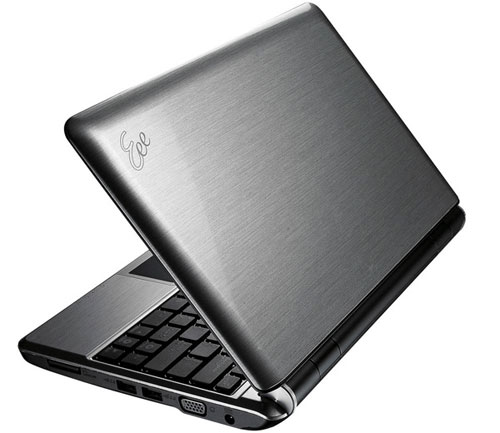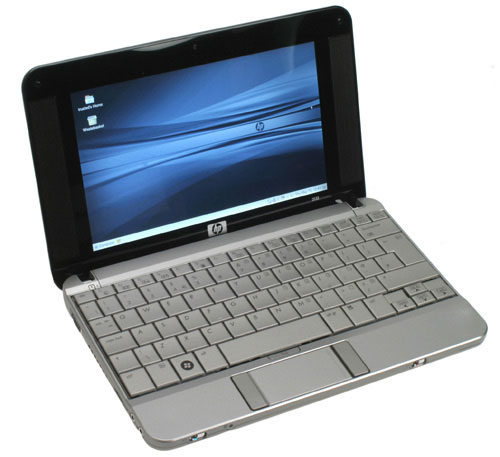Netbooks are increasingly 'close to' laptops
It's easy to distinguish a netbook from a laptop, but the difference between them is getting less and less .
Netbooks usually have screens from 8 to 10 inches and do not have an integrated optical drive. There are no full-sized netbooks like laptops, so the keyboard is smaller, only 89-93% of the normal size. Therefore, those who are unfamiliar with typing will experience more errors when typing than laptops.
The netbook also has full connectivity, like 2 or 3 USB ports, Webcam, SD memory card reader, Wi-Fi connection. Some models also include ExpressCard expansion slot, Bluetooth and even modem. Most models feature Intel Atom processors, integrated graphics cards, and memory from 512 MB to 1 GB.

Asus Eee PC 1000HE 10 inch screen. Photo: Gadgetmix .
It is impossible to underestimate the potential of these 'small' computers. Their capabilities are not only confined to web surfing, basic office applications such as spreadsheets and word processing. Many netbooks can now be edited with images of 'massive' software such as Adobe Photoshop Elements 7. If you are a bit patient, you can convert video formats with good Windows Media Encoder software. Adobe Premiere Elements 7, or open the entire music library with Apple iTunes. Watching videos on You Tube video or opening movies directly from USB does not get jerky. For entrepreneurs, these machines are very suitable because they can install e-mail applications or set up VPNs and run anti-spyware programs.

Acer Aspire One uses Intel Atom 1.6 GHz chip. Photo: Aceraspireoneguide .
In order to have a netbook as good as possible, note the basic instructions for configuring the machine. Start with the operating system. Linux operating systems are cheaper and the user interface is also quite friendly, while Windows is more familiar and preferred. Moreover, Windows operating system has many support services, hardware, software, application compatibility while with Linux, users will need time to explore, get familiar with the new interface, the way Software installation, and hardware management. By this time, with the appearance and gradual upgrade of Windows 7 version suitable for both netbooks, Linux will be difficult to get a firm position in this 'fertile' market.
Netbook uses two types of hard drives: traditional HDD hard drives and SSD solid-state drives. While SSDs have faster data transfer speeds, longer durability, and longer life cycles than traditional HDD drives, the cost is still high and the capacity is limited. Therefore, most netbooks are equipped with traditional HDD drives with a capacity of 160 GB, or at least 60 GB with a rotation speed of 5,400 rpm.
Intel Atom is the fastest and most energy-efficient processor. There are also Intel Celeron M processors and VIA chips in the first generation machines such as Asus Eee PC 4G and HP 2133 Mini-Note. Many netbooks work well with 1 GB of RAM running on Windows XP Home Edition operating system.

HP 2133 Mini-Note. Photo: Eee PC .
The standard battery for netbooks is a 3-cell battery with a capacity of less than 30Wh, some models like Asus Eee PC 1000HE, Acer Aspire One (10 inches), and Samsung NC10 - 14 GB have been upgraded to a 6-cell battery. While with 3-cell battery, the machine can operate continuously for 2, 3 hours, while with 6-cell battery, the time is up to 6-8 hours. If you need to move constantly or take classes all day, 6 cell battery will be a reasonable choice.
Some special features that are not yet well-equipped on popular laptops are now available with netbooks. For example, the HP Mini 1000 includes a broadband modem capable of connecting and receiving broadband signals. Meanwhile, high-end netbook Asus N10Jc with Nvidia discrete graphics card, users can also play games. Asus N10Jc is also equipped with an Intel GMA 950 integrated card that offers many options with the ability to switch between two cards to improve graphics processing efficiency and save power, extend battery life.
Some models have moved to run Windows 7, the next version of Microsoft Windows Vista. The Dell Inspiron Mini 12 is the first model with a 12-inch screen. Manufacturers have also focused more on design, the machine is more beautiful and more sophisticated but still ensures an important element of maintaining low selling prices.
You should read it
May be interested
- Full package of accessories for netbooks
 acer a180-1221 is a complete and high-end accessory package for netbooks, which ensures the device can read dvds or shock-resistant leather bags.
acer a180-1221 is a complete and high-end accessory package for netbooks, which ensures the device can read dvds or shock-resistant leather bags. - Netbooks run out of life
 netbooks have been hailed as a star in the field of mobile computing devices. with the strong rise of tablets, will it last longer?
netbooks have been hailed as a star in the field of mobile computing devices. with the strong rise of tablets, will it last longer? - How to prevent harms when using a long-term laptop
 the time spent studying, working and entertaining on the laptop is increasingly being abused by many people regardless of day and night to lead to serious harms affecting our health that few people care about. .
the time spent studying, working and entertaining on the laptop is increasingly being abused by many people regardless of day and night to lead to serious harms affecting our health that few people care about. . - 10 useful tips for laptop users
 laptops are increasingly popular, but the way to use laptops properly is not everyone knows. here are 10 guidelines recommended by many computer manufacturers when using laptops.
laptops are increasingly popular, but the way to use laptops properly is not everyone knows. here are 10 guidelines recommended by many computer manufacturers when using laptops. - 10 tips for extending netbook capabilities
 one notable limitation of netbooks is the storage capacity. but the internet can help you solve these problems.
one notable limitation of netbooks is the storage capacity. but the internet can help you solve these problems. - Top 5 healthy battery netbooks
 netbook is no match for laptops in terms of performance but affordable, high mobility and especially good battery life.
netbook is no match for laptops in terms of performance but affordable, high mobility and especially good battery life. - Apple doesn't like netbooks
 although rumors that apple will make netbooks cause a 'fever' in the market, the company itself claims that mini laptops are not useful.
although rumors that apple will make netbooks cause a 'fever' in the market, the company itself claims that mini laptops are not useful. - How to close the application on Android
 having too many open applications at the same time can sometimes slow your device. navigating away from the application may still allow the application to continue to run in the background, so the only way to close the application is to do it manually.
having too many open applications at the same time can sometimes slow your device. navigating away from the application may still allow the application to continue to run in the background, so the only way to close the application is to do it manually. - Asus and Acer didn't release new netbooks until 2010
 instead of netbooks, these two major manufacturers will focus on ultra-thin laptops in the second half of this year.
instead of netbooks, these two major manufacturers will focus on ultra-thin laptops in the second half of this year. - Small laptops MSI Wind has new members
 it is expected that next month msi will release a new version of the tiny wind laptop with a longer battery life than the current version.
it is expected that next month msi will release a new version of the tiny wind laptop with a longer battery life than the current version.










 The Eee PC with the first optical drive was released in April
The Eee PC with the first optical drive was released in April Sony Vaio FW351J / H, cheap Bluray laptop
Sony Vaio FW351J / H, cheap Bluray laptop HP Pavilion dv4-1300
HP Pavilion dv4-1300 Laptop errors are still attractive with cheap 'post'
Laptop errors are still attractive with cheap 'post' Nice laptop and personality
Nice laptop and personality Acer launched the Aspire One D250 ultra-thin
Acer launched the Aspire One D250 ultra-thin